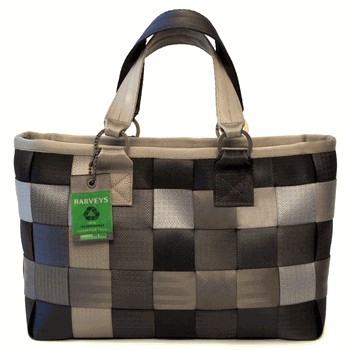And now for something completely different. But first, a definition from Wikipedia, in case "hooptie" wasn't in your vocabulary as yet:
Hooptie ... an old, decrepit, unreliable and often nonfunctional car which has limited mechanical abilities and is often in an unmaintained and usually in a rusty or dented shape.

Harveys Carriage Satchel treecycle bag, using recycled seat belt webbing, $228
In other words, that rusty, barely running 1986 Buick Century with no hubcaps and a cracked windshield that your neighbor uses to lurch to and from the grocery store, but no further? That's a hooptie.
So what to do with old cars once they're really and truly dead? Last summer's Cash for Clunkers program required that dealers destroy the engines, but allowed the rest of the traded-in vehicle to be dismantled and sold. Auto recyclers are still coping with the backlog.
Carmakers now use recycled materials in various parts. For the rest of us, especially those among our readers who carry purses, E: The Environmental Magazine has some ideas on how to leftover car parts to make ... handbags.
Turns out there's a huge industry of craftspeople out there who recycle license plates, inner tubes, even seat belts into handbags, some of them sold at breathtakingly high multiples of the cost of the discarded material. Our two favorite examples:
Harveys, which created the first Seatbeltbag, uses entirely reclaimed seat-belt webbing in its Treecycle line, along with organic hemp and water-based inks. (It also makes bags out of virgin webbing too.) The Carriage Satchel treecycle (13 x 9 x 4 inches) is $228.
And those old license plates that stack up in your garage? Littlearth, of Pittsburgh, turns 50,000 of them a year into its Fender Handbags, using one pair each and a recycled rubber strap. You can even pick your state. The standard item costs $140, but if you want Swarovski crystals, it goes up to $250.
[Emagazine; hat tip: Carolyn Ward]













